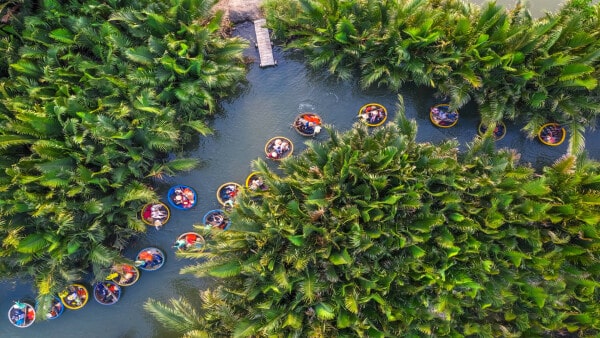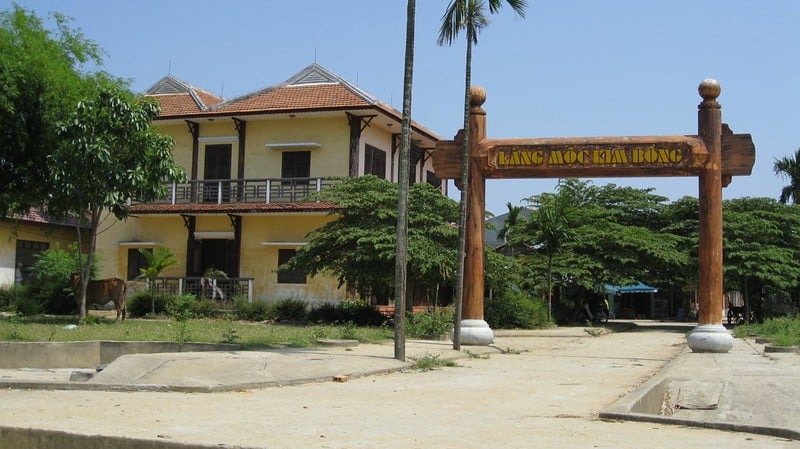Exploring the villages of the Hoi An countryside
Venturing beyond the Hoi An Ancient town gives you the opportunity to explore beautiful landscapes, mingle with locals & partake in some craftsmanship.

Unesco World Heritage site, Hoi An, is a magical little town located in the central province of Quang Nam in Vietnam, easily accessible from Da Nang. Thanks to its beautiful ancient Japanese and Chinese cultural influences on architecture and colorful lantern-lit alleyways, the town ends up on countless Instagram feeds and stories. However, most travelers don’t venture beyond the borders of the Ancient town in search of adventure. What they don’t know is that the Hoi An countryside is dotted with numerous villages, some well-known for a certain trade in the region. One for pottery, one for farming, another for carpentry and ship-building and more. It’s time to explore these!
Thanh Ha Pottery Village
To the residents of Thanh Ha Pottery Village, pottery is more than just an art form, it’s been an important means of livelihood for the past 400 years. During the Nguyen Dynasty, the skilled craftsmen of the village were invited to create some decorative articles for the palace. The craftsmen were able to impress the Nguyen Lords with their beautifully intricate pieces which ultimately put the village on the map. This one-off event was enough to grant them sufficient renown to last a lifetime. Now the village is able to sustain itself primarily through exports and tourism.

Thanh Ha Pottery Village is located a mere 3 kilometers from the center of Hoi An, and you can reach it with a quick drive or walk under the midday sun. Walking through the village, past the humble homes of pottery workers, you will see all sorts of items in various stages of production, stacked sometimes five feet high by the entrances. Pottery work, as you will see, includes almost everything you can think of, from cups, jars and bowls to pots, incense burners and more. What’s especially beautiful about Thanh Ha is that nothing here is mechanised and all pottery items are made by skilled, fragile hands, using traditional clay mixing, moulding, burning and baking techniques. These craftsmen and women are extremely adept and have been making pottery as far as they can remember.
Spend some time walking through the village, talking to the kind strangers. Some of their homes are open as workshops too. Don’t expect anything fancy with a clean set up – you will be doing exactly what they do: sitting on the floor and getting your hands dirty as you mould clay into various shapes. This is a fantastic souvenir to take home and keep or gift to your loved ones (especially if it ends up looking good!) Pottery work are also available for sale and you will be doing the craftsmen and women a big favor.
Pro tip: When heading back to Hoi An Ancient Town from Thanh Ha, take the road that runs next to the river. You will come across some coffee shops with hammocks strung between palm trees – a great way to take a break.
Tra Que Vegetable Village
Tra Que Village is an incredibly peaceful getaway in the Hoi An countryside, located a 3 kilometers northeast of the Ancient Town. This village, the first of its kind in Vietnam, has been responsible for the flavors of the region for the past 300 or so years, as many establishments and individuals source their greens from the farmers that work here. What singles out this farm from the rest is that traditional farming practices passed through generations are still in place, directly translating to the quality and taste of the vegetables and herbs growing here. All of which you can observe as you walk through this green, clean and picturesque village.

With lush grasslands and tranquil lakes, the village covers about 40 hectares of land. The best way to explore it is by foot or on bicycle, pedaling peacefully through the rows of neatly arranged plants. You can even stop for a minute or two to partake in some farming activities such as planting, watering or harvesting the greens. If you head toward the De Vong River, you can even try your luck fishing for some shrimp. Beyond that, there are numerous restaurants here serving wholesome, plant-based menus where you can enjoy a delicious meal with a view of the peaceful countryside.
Another extremely popular activity to do in Tra Que is to partake in a cooking class. These classes arrange the aforementioned activities, down to the plants you will be harvesting as these will be the ingredients used in the menu you will be learning to cook. You will not only learn the secrets behind Vietnam’s flavors, but also have a really fun time doing it.
Pro tip: There are numerous accommodations scattered around the village. We recommend you spend a night so you can start the next morning over the marvelous rice fields.
Kim Bong Carpentry Village
Kim Bong Carpentry Village is the lesser known and visited of all the villages in this list, but undeservedly so. The village dates back to the 15th century, having originated in the north of Vietnam, and somehow making its way to the central region and settling down. Throughout the years, the artisans here have worked on furniture and houses across the country, from prominent buildings in Hanoi to the Imperial City of Hue and the tomb of Ho Chi Minh. The ancestors of those carpenters residing in the village now, even built trading vessels and warships for the Spanish Navy 400 years ago.

The traditions remain. While exploring the village, you are able to watch these adept craftsmen and women in action, doing what they do best. Just like Thanh Ha Pottery Village, Kim Bong sustains itself through exports and tourism. The furniture, religious statues and other finely crafted pieces of work can be found and bought in souvenirs shops around the region and country, and it won’t cost you much to purchase something as a souvenir. To get to the village, you can board a boat from Ancient Town, at Bach Dang Street. The journey there will be an adventure in itself. Once here, you can also participate in some wood-carving activities with the craftsmen.
Cam Thanh Coconut Village
Located about 5 kilometers from the center of Hoi An, Cam Thanh Coconut Village remains one of the most-visited villages in the Hoi An countryside, albeit not by many, thanks to its vast and beautiful water coconut palm forest. Once a local shelter for fighters and civilians alike during lengthy times of war, it has now become somewhat of an ecotourism destination for travelers, and a provider of seafood for the region. To try some of this delicious seafood, head over to Coconut Fragrance Restaurant, Long Phu restaurant or Phat Loc restaurant. These venues serve delicious seafood and coconut-based dishes and a meal will simply cost you about USD $10.00 per person.

While a huge chunk of your experience at Cam Thanh Coconut Village takes an educational angle where you get to learn about how coconut has become an integral part of the daily life of the Vietnamese fishermen, their families and their community, it will also take an extremely fun turn the moment you board a bamboo basket boat. This is a daily method of transport for the residents of the village, and a must-do activity for travelers. Get behind the oar and row through the tranquil maze of waterways. Partake in some coconut crafts such as making jewelry, headwear and even paintings. There are some restaurants in the village to enjoy a coconut-based meal or even a cooking class. It will be an exciting and relaxing day.
Hoi An in Vietnam is one of those places you must visit at least once in your lifetime. The beauty of the Ancient Town will enchant you, but it is these villages, the people, their kindness and their smiles that will make you want to visit again and again. Make sure you spend a couple of days in the area so you can make the best of your time and enjoy Hoi An for everything it offers.






